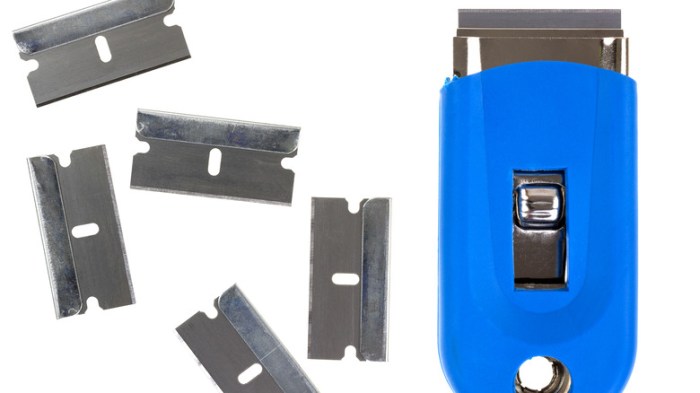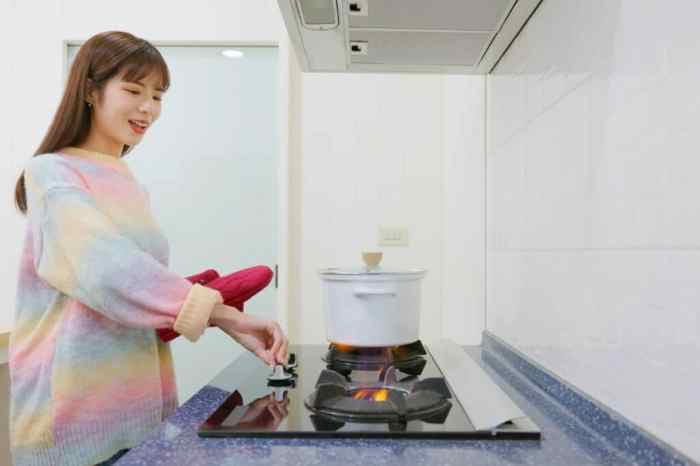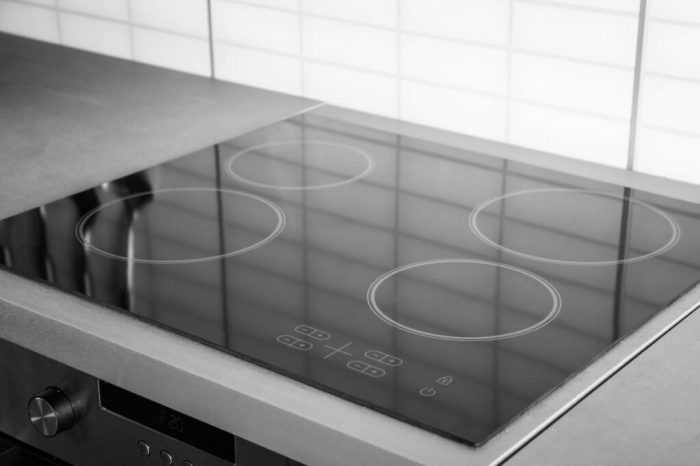Electric glass-top stoves are gaining popularity for their sleek design, precise temperature control, and ease of cleaning. This comprehensive guide delves into the features, benefits, and considerations of these modern cooking appliances, comparing them to gas and induction models. From detailed cleaning instructions to safety tips and insights into future trends, this exploration provides a complete picture of electric glass-top stove technology.
This in-depth analysis examines various aspects of electric glass-top stoves, including heating element types, available sizes and styles, and the unique challenges and advantages compared to traditional stove types. The guide also offers valuable insights into installation, maintenance, and safety protocols, allowing consumers to make informed decisions when considering this modern cooking solution.
Overview of Electric Stoves with Glass Tops
Electric glass-top stoves have rapidly become a popular choice for home kitchens, offering a blend of modern aesthetics and convenient functionality. Their smooth, easy-to-clean surfaces and precise temperature control have attracted consumers seeking both style and efficiency in their cooking experience. This dominance is driven by the inherent advantages they present over other stove types, notably in terms of ease of maintenance and the ability to quickly adjust heat settings.Electric glass-top stoves provide a sleek and contemporary look.
The smooth surface minimizes the accumulation of food particles, making cleaning a simple task. Furthermore, the digital controls and precise temperature regulation allow for more precise cooking, leading to better results and reducing cooking time.
Heating Element Types
Electric glass-top stoves utilize various heating elements to generate heat. Understanding these elements is crucial for selecting the right stove for individual cooking needs. Different heating elements produce heat at varying rates and intensities.
- Resistance Heating Elements: These are the most common type, utilizing a coil or wire that heats up when electricity passes through it. They are generally reliable and provide consistent heat distribution. A significant advantage is their relatively low initial cost compared to other types.
- Induction Heating Elements: These elements generate heat by inducing eddy currents in a magnetic field. The cookware itself becomes the heating element, resulting in a quicker and more efficient cooking process. The induction method is more energy-efficient and is able to precisely control the heat, although they can be more expensive initially.
Sizes and Styles
Electric glass-top stoves come in a wide range of sizes and styles, catering to diverse kitchen needs and preferences. The choice of size and burner configuration is a significant factor in selecting a stove that aligns with your cooking habits.
- Single-Burner Models: Ideal for smaller kitchens or apartments, these models are often compact and economical. The advantage is simplicity and affordability, while the drawback is limited cooking capacity.
- Multiple-Burner Models: These are the most common choice, featuring two to six burners, catering to larger households or more extensive cooking demands. The advantage is the ability to cook multiple dishes simultaneously, and the drawback can be the higher price point.
- Cooktops with Specialized Burners: Some models offer specialized burners for specific cooking tasks, such as warming zones or large-area burners. This allows for more focused and efficient cooking, although the extra features come with an increased price.
Materials and Construction
The materials used in constructing electric glass-top stoves significantly impact their durability, aesthetic appeal, and overall performance.
| Feature | Description | Example Models |
|---|---|---|
| Glass Surface | Typically made from tempered glass, which is highly durable and resistant to thermal shock. This ensures longevity and prevents cracking under normal use. | Many models from leading brands like GE, Samsung, and LG. |
| Frame/Base Material | The frame and base material of the stove are usually made of sturdy metals like cast iron or stainless steel, which provide stability and heat dissipation. These materials are known for their longevity and ability to maintain consistent temperature. | Various models from major appliance manufacturers. |
| Controls | Controls vary from simple knobs to advanced touchscreens. Modern models often incorporate digital displays for precise temperature settings and cooking timer functions. | Examples include models from brands like Whirlpool and Bosch. |
Comparison with Other Stove Types

Electric glass-top stoves, while popular for their sleek aesthetics and ease of cleaning, face competition from traditional gas and increasingly popular induction models. Understanding their strengths and weaknesses relative to these alternatives is crucial for consumers seeking the optimal cooking solution. Choosing the right stove depends on individual needs, priorities, and budget.Electric glass-top stoves offer a distinct set of advantages and disadvantages compared to their gas and induction counterparts.
Their smooth surfaces are inherently easier to clean, and their even heat distribution is well-suited for many cooking tasks. However, the slower heating and cooling times can sometimes be a drawback, particularly for tasks demanding rapid temperature changes.
Electric vs. Gas Stoves
Electric glass-top stoves generally exhibit slower heating and cooling rates than gas stoves. This difference in heating response impacts cooking times, especially for tasks requiring rapid temperature fluctuations, such as searing or boiling. Gas stoves, on the other hand, provide a more immediate and controllable heat source. However, gas stoves require regular maintenance, including the occasional burner replacement and venting, adding to the long-term operational cost.
Furthermore, concerns about gas leaks and the potential for accidents associated with open flames are often a significant consideration for consumers. Electric stoves provide a safer alternative, minimizing these risks.
Electric vs. Induction Stoves
Electric glass-top stoves and induction stoves both utilize electricity, but their heating mechanisms differ significantly. Induction stoves heat cookware directly, resulting in quicker heating times and more precise temperature control. This rapid heating is highly advantageous for tasks requiring rapid temperature adjustments. Electric glass-top stoves, however, heat the cooktop surface, which then transfers heat to the cookware. This process is generally slower than induction.
Additionally, electric glass-top stoves may not be as responsive to frequent adjustments in cooking temperatures as induction models. The upfront cost of induction cooktops can be higher, but the energy efficiency and responsiveness frequently outweigh the initial investment for many consumers.
Energy Efficiency
Electric glass-top stoves generally have a lower energy consumption rate compared to gas stoves. However, the efficiency varies significantly depending on factors like the model, the cooktop material, and the cookware used. Induction stoves often demonstrate higher energy efficiency due to their direct heating method. The reduced heat loss in induction stoves leads to lower energy consumption, potentially resulting in long-term cost savings.
Furthermore, modern electric glass-top stoves often incorporate features designed to optimize energy use.
Comparative Table
| Feature | Electric Glass Top | Gas | Induction |
|---|---|---|---|
| Cost | Moderate | Moderate | Higher |
| Cleaning | Easy | Moderate | Easy |
| Safety | High | Moderate (with proper maintenance) | High |
| Cooking Speed | Moderate | Fast | Fast |
| Energy Efficiency | Good | Lower | Excellent |
| Maintenance | Low | Moderate | Low |
Cleaning and Maintenance
Maintaining a pristine glass-top electric stovetop is crucial for its longevity and aesthetic appeal. Proper cleaning prevents the build-up of grime, food particles, and mineral deposits, ensuring optimal performance and safety. Neglecting maintenance can lead to premature damage and potentially hazardous situations.Effective cleaning goes beyond a quick wipe-down. It involves understanding the specific materials and construction of the glass top, recognizing potential hazards, and employing the correct techniques to prevent damage and ensure a spotless finish.
Specific Cleaning Procedures
Glass-top electric stoves are designed with durability in mind, but specific cleaning procedures are vital to preserving their surface. Abrasive cleaners and harsh scouring pads should be avoided, as they can scratch the glass, compromising its integrity and appearance.
Recommended Tools and Techniques
A variety of tools can aid in cleaning a glass-top electric stove. A soft sponge or cloth, mild dish soap, and warm water are generally sufficient. For stubborn spills or baked-on food, a specialized glass cleaner or a mixture of baking soda and water can be employed. Microfiber cloths are recommended for their ability to effectively absorb liquids and avoid scratching.
Avoid using steel wool, abrasive scrubbers, or scouring powders, as these can scratch the glass surface.
Preventing Spills and Burns
Preventing spills is paramount to maintaining a clean and safe stovetop. Carefully managing cookware, particularly when cooking with hot liquids or ingredients, can help minimize the risk of spills. Using pot holders or oven mitts when handling hot cookware is critical to preventing burns. Promptly addressing any spills as they occur is essential to avoid the formation of stubborn residue.
Importance of Regular Maintenance
Regular maintenance is key to preventing potential problems. Regular cleaning, as part of a routine maintenance schedule, prevents the accumulation of food particles, grease, and mineral deposits, which can damage the stovetop’s surface over time. Early detection of minor issues like cracks or discoloration can prevent further damage and potentially expensive repairs.
Identifying Potential Problems Early
Regular visual inspections of the glass top can reveal early signs of damage. Look for any cracks, chips, or discoloration. Uneven heating patterns or unusual noises during operation should also be investigated. Prompt attention to these signs can prevent significant issues and costly repairs down the road.
Step-by-Step Guide to Cleaning a Glass-Top Electric Stove
- Preparation: Turn off the stove and allow it to cool completely. Unplug the stove if possible for added safety.
- Pre-Cleaning: Remove any loose food particles or debris from the stovetop using a soft brush or spatula. This step will make the subsequent cleaning process more efficient.
- Cleaning Solution: Prepare a cleaning solution by mixing a small amount of mild dish soap with warm water in a bowl. Avoid using harsh chemicals or abrasive cleaners.
- Cleaning the Surface: Dip a soft sponge or cloth into the cleaning solution. Gently wipe the entire stovetop surface in circular motions. Focus on areas with spills or stubborn residue.
- Rinse and Dry: Rinse the stovetop with clean water and dry it thoroughly with a clean, microfiber cloth. This will prevent water spots or streaks from forming.
- Additional Cleaning: For stubborn spills or baked-on food, use a glass cleaner or a paste made from baking soda and water. Apply the paste to the affected area, let it sit for a few minutes, and then scrub gently with a soft sponge. Rinse and dry thoroughly.
Types of Spills and Their Cleaning
- Water-Based Spills: These are usually the easiest to clean. Wipe up the spill immediately with a damp cloth and then dry thoroughly to prevent water spots.
- Food Spills (e.g., sauces, eggs): Act quickly to prevent the spill from drying. Use a damp sponge or cloth to wipe away as much of the spill as possible. For stubborn residue, use a glass cleaner or baking soda paste.
- Grease Spills: Grease can be particularly challenging to remove. Apply a small amount of dish soap to a damp cloth and wipe the area. If the grease is baked on, try using a paste of baking soda and water and let it sit for a few minutes before scrubbing gently.
- Sticky Spills (e.g., honey, caramel): Sticky spills are best tackled by using a scraper to remove as much of the spill as possible. Then, use a damp cloth with a small amount of dish soap to wipe away the remaining residue. For particularly stubborn spills, try using a glass cleaner or a mixture of isopropyl alcohol and water.
Safety Features and Considerations

Electric glass-top stoves, while offering convenience and aesthetic appeal, require careful consideration of safety features and potential hazards. Understanding the built-in safeguards and potential pitfalls is crucial for safe and effective use. Proper knowledge of these elements empowers users to prevent accidents and maintain a secure cooking environment.Electric glass-top stoves, despite their modern design, are susceptible to certain safety risks.
Manufacturers incorporate various safety mechanisms to mitigate these dangers. However, user awareness and adherence to safety protocols remain paramount for injury prevention and damage avoidance.
Automatic Shutoff Mechanisms
Many electric glass-top stoves are equipped with automatic shutoff mechanisms. These systems detect a lack of cookware or excessive heat and automatically interrupt the power supply to the heating elements. This prevents overheating and potential fires if the stove is left unattended or if the cookware is accidentally removed. A properly functioning automatic shutoff is a critical safety feature for preventing accidents.
Temperature Controls
Temperature controls on electric glass-top stoves allow users to precisely adjust the heat output. This precision enables more controlled cooking processes and minimizes the risk of food burning or overcooking. Precise temperature control also reduces the likelihood of overheating and potential damage to the stovetop surface. The controls provide a layer of safety by enabling the user to regulate the heat according to the needs of the dish.
Potential Safety Hazards and Mitigation
While electric glass-top stoves offer numerous advantages, certain hazards are possible. One potential hazard is overheating if the stove is left unattended or if the cookware is inappropriate for the heat setting. Using the correct size and type of cookware, as well as monitoring the cooking process, mitigates this risk. Another potential hazard is the risk of burns from hot surfaces.
Handling hot cookware with caution and using oven mitts or pot holders reduces the risk of burns.
Safety Tips for Use
- Always use the appropriate size cookware on the heating elements to prevent uneven heating and potential damage.
- Never place any flammable materials on the hot surface.
- Keep children and pets away from the stove when it is in use.
- Inspect the stovetop for any damage or cracks regularly, and report any issues immediately.
- Ensure that the power cord and plug are in good condition and are not damaged.
These safety tips highlight the importance of proactive measures to minimize potential risks associated with using electric glass-top stoves.
Safety Features Comparison
| Stove Model | Automatic Shutoff | Temperature Control Range | Burner Type |
|---|---|---|---|
| Model A | Yes, with overheat protection | Low to High | Ceramic |
| Model B | Yes, with overheat and empty pan detection | Low to Extra High | Induction |
| Model C | Yes, with overheat protection and auto-shutdown | Low to Medium High | Electric |
This table provides a basic comparison of safety features across different electric glass-top stove models. Note that specific features and capabilities may vary based on the manufacturer and model.
Cooking Performance and Capabilities

Electric glass-top stoves have rapidly gained popularity for their sleek design and touted efficiency. Their performance, however, extends beyond aesthetics. Understanding their heating capabilities and how to optimize results is key to unlocking the full potential of these modern kitchens.Electric glass-top stoves excel in consistent and responsive heating. This allows for precise temperature control, crucial for delicate dishes and complex recipes.
Their speed and even heat distribution are also significant factors in achieving optimal cooking outcomes.
Heating Speed and Temperature Control
Electric glass-top stoves offer rapid heating times, often surpassing traditional electric coil models. This speed advantage is particularly noticeable in tasks like boiling water or bringing pans to a simmer. The rapid response time of the heating elements allows for faster cooking times, which can save precious time in a busy kitchen. Precise temperature control is a key element in achieving the desired cooking results.
Modern models incorporate digital displays and controls for accurate temperature settings and precise temperature maintenance.
Even Heating Distribution
Even heating is a significant benefit of electric glass-top stoves. The precise distribution of heat across the cooking surface prevents hot spots and cold spots, ensuring consistent cooking. This is especially crucial for dishes that require uniform cooking, such as sauces, soups, and stir-fries. The even heat distribution is also ideal for maintaining consistent temperatures during prolonged cooking.
Achieving Optimal Cooking Results
Several strategies can optimize cooking performance on electric glass-top stoves. Using appropriate cookware is essential. Cast iron or stainless steel cookware with flat bottoms often provides the best results due to their ability to distribute heat evenly. A good technique is to preheat the pan to the desired temperature before adding ingredients. This ensures that the heat is distributed effectively from the start.
Moreover, using smaller pans or dishes allows for better heat distribution and more focused cooking.
Dishes Well-Suited for Electric Glass-Top Stoves
Electric glass-top stoves are suitable for a broad range of culinary endeavors. Dishes that benefit from even heating and rapid temperature changes are ideal choices. For example, sauces, soups, and stews, which require consistent heat distribution throughout, can be easily and effectively cooked on these stoves. Similarly, stir-fries, which necessitate rapid cooking and heat distribution, thrive on the quick heating capabilities.
Comparison with Other Stove Types
Electric glass-top stoves typically offer faster heating times compared to traditional gas stoves. While gas stoves might have a perceived advantage in some instances, such as searing meats, electric glass-top models often offer better control over temperature and more even heating distribution, making them suitable for a wide variety of cooking tasks. Gas stoves, in contrast, may exhibit variations in heat intensity.
Installation and Setup

Electric glass-top stoves offer convenience and sleek aesthetics, but their installation demands careful attention to detail. Proper installation ensures safe operation and longevity, avoiding potential hazards. Ignoring safety protocols during installation can lead to electrical shocks, fire hazards, and stove malfunctions.Careful adherence to manufacturer instructions is crucial for a successful installation. The process involves several critical steps, ranging from verifying electrical requirements to connecting the stove to the power supply.
This meticulous approach minimizes the risk of future issues and guarantees the stove’s optimal performance.
Essential Precautions
Proper grounding and electrical connections are paramount for safe operation. Failure to adhere to electrical codes can result in significant safety risks. Always consult a qualified electrician if unsure about any aspect of the electrical installation. Incorrect grounding can lead to electrical shocks or even fire hazards. Furthermore, ensuring the stove’s placement adheres to the manufacturer’s guidelines prevents potential structural issues and stove instability.
Electrical Connection Requirements
Adequate electrical wiring is vital. The stove’s power requirements should align with the available electrical supply. A dedicated circuit is recommended for optimal performance and safety. Insufficient amperage can lead to overheating and damage. Using a GFCI (Ground Fault Circuit Interrupter) outlet is highly advisable to provide additional safety.
Grounding and Safety Procedures
Proper grounding is non-negotiable for electrical appliances. A properly grounded stove significantly reduces the risk of electrical shocks. Ensure the stove’s grounding wire is securely connected to a grounded electrical system. The ground wire is critical to completing the electrical circuit and preventing dangerous voltage surges.
Step-by-Step Installation Guide
- Preparation: Carefully inspect the installation area to ensure it meets the manufacturer’s specifications for the stove’s dimensions and electrical requirements. Clear the area of obstructions and ensure sufficient space around the stove for ventilation and access. Verify the electrical supply can accommodate the stove’s power needs. Consult the installation manual for detailed dimensions and electrical requirements.
- Plumbing Connections (if applicable): If the stove is equipped with a built-in oven or other components requiring plumbing connections, ensure all plumbing connections are complete and functional before proceeding. Confirm that all connections are properly sealed and leak-free. Incorrect or inadequate plumbing can cause leaks or water damage. Use appropriate plumbing tools and sealants.
- Electrical Connections: Disconnect the power supply to the electrical outlet before making any connections. Ensure the stove’s grounding wire is securely connected to the grounded electrical system. Follow the manufacturer’s instructions for connecting the power cord and ensuring proper grounding.
- Placement and Leveling: Carefully place the stove on its designated location. Use the provided leveling legs or feet to ensure the stove is perfectly level. Uneven placement can lead to instability and damage. Verify the stove’s stability and secure it accordingly.
- Final Checks and Testing: After completing all connections, reconnect the power supply. Perform a thorough inspection of all connections to ensure they are secure. Test the stove’s functionality to confirm it operates as expected. Check all controls, burners, and oven functions.
Energy Efficiency and Environmental Impact
Electric glass-top stoves, while offering a sleek aesthetic and responsive cooking experience, also present a unique energy profile compared to other stove types. Understanding their energy efficiency and environmental footprint is crucial for informed consumer choices. This assessment delves into the energy consumption, environmental benefits, and the role of energy-star ratings in shaping the sustainability of these appliances.The energy consumption of electric glass-top stoves is influenced by factors such as the stove’s wattage, the size of the heating element, and the cooking method employed.
Lower wattage models and more efficient cooking techniques translate to lower energy bills and a reduced environmental impact.
Energy Consumption Comparison
Electric glass-top stoves generally consume less energy during typical use compared to gas stoves, particularly for simmering or low-heat cooking. However, their energy efficiency is dependent on the appliance’s specific design and usage patterns. The energy efficiency of electric ranges, which typically include an oven, is influenced by the oven’s usage as well.
Energy Star Ratings
The Energy Star program, a US government initiative, establishes energy efficiency standards for various household appliances, including electric glass-top stoves. Products achieving Energy Star certification demonstrate a commitment to lower energy consumption, thereby contributing to reduced energy bills and a smaller environmental footprint. Energy Star ratings, which are usually displayed on the product label, can serve as a valuable guide for consumers seeking energy-efficient appliances.
This rating system considers factors like the appliance’s power consumption and overall design for optimal energy usage.
Environmental Benefits
Electric glass-top stoves offer several environmental advantages over their gas counterparts. Firstly, they eliminate the emissions of greenhouse gases and volatile organic compounds (VOCs) often associated with gas stovetop operation. This reduction in emissions contributes to cleaner air quality and a lower carbon footprint. Secondly, the absence of gas lines and fuel storage reduces the risk of leaks and accidents.
Furthermore, electric glass-top stoves are generally easier to maintain, which translates to less waste over their lifespan.
Energy Efficiency Metrics
Several metrics quantify the energy efficiency of electric glass-top stoves. Watts per square inch of heating element, the maximum temperature attainable, and the time required to reach specific temperatures are key factors in assessing efficiency. For instance, a stove with a lower wattage but still capable of quickly reaching desired temperatures may be more energy-efficient for specific cooking tasks.
Manufacturers often publish data on energy consumption under various conditions, enabling informed comparisons. Data on the actual energy consumption of these appliances in a home environment, gathered through real-world usage, is crucial for comprehensive evaluation.
Impact of Cooking Habits
Cooking habits play a significant role in the energy efficiency of electric glass-top stoves. Techniques such as minimizing the time spent heating the stovetop, using appropriate pot sizes, and maintaining consistent heat settings contribute to lowering energy consumption. For example, using a larger pan than necessary to heat a small amount of food leads to increased energy usage.
User Reviews and Customer Feedback
Electric glass-top stoves have become a popular choice for home cooks, but user experiences vary. Understanding customer feedback is crucial for evaluating the strengths and weaknesses of this technology. Consumer reviews offer valuable insights into the practical aspects of operation, cleaning, and overall satisfaction with these appliances.Consumer reviews consistently highlight both the advantages and drawbacks of electric glass-top stoves, offering a nuanced perspective on their performance and practicality.
This section summarizes those reviews, providing a comprehensive overview of customer opinions to help potential buyers make informed decisions.
Common Praise and Complaints
User reviews overwhelmingly praise the sleek design and modern aesthetic of electric glass-top stoves. Their smooth surfaces are easy to clean, a significant advantage over traditional stovetops. Many appreciate the precise temperature control and rapid heating capabilities, allowing for efficient and controlled cooking. However, concerns exist regarding the potential for accidental damage to the glass surface and the difficulties in spotting small spills.
Overall Customer Satisfaction
Customer satisfaction with electric glass-top stoves tends to be high, although not universally positive. Reviews frequently mention the convenience and aesthetic appeal as major selling points. However, concerns about durability and potential maintenance issues remain.
Review Summary
A structured review summary reveals a mixed bag of experiences. Average ratings for various models show a positive trend, with most models scoring above 4 out of 5 stars. However, ratings often vary depending on specific features, construction materials, and manufacturer reputation.
Categorized User Feedback
| Category | Positive Comments | Negative Comments |
|---|---|---|
| Ease of Cleaning | “Incredibly easy to clean, wipe down in seconds.” “Smooth surface makes cleaning a breeze.” | “Difficult to spot and clean small spills immediately.” “Some stubborn spills require special cleaning.” |
| Cooking Performance | “Fast heating and precise temperature control.” “Great for stir-frying and other quick-cooking methods.” | “May not distribute heat as evenly as other stove types.” “Certain pans may not heat uniformly.” |
| Durability | “Glass surface seems durable and resistant to scratches.” “Well-constructed, no signs of wear and tear.” | “Glass can be fragile and prone to damage from heavy pots or dropped objects.” “Some models have reported cracking or shattering incidents.” |
| Aesthetics | “Sleek and modern design enhances kitchen aesthetics.” “Matches contemporary kitchen styles.” | “The glass top can reflect light, potentially causing glare.” “Some users found the glossy surface too reflective.” |
Future Trends and Innovations

The electric glass-top stove market is poised for significant advancements, driven by consumer demand for enhanced performance, safety, and user experience. Innovations are focusing on improving efficiency, addressing potential drawbacks, and incorporating smart technologies for seamless integration into modern kitchens. These changes promise to redefine the cooking experience, offering more precise control, intuitive interfaces, and a more sustainable approach to home cooking.Electric glass-top stoves are evolving beyond their current capabilities, moving toward greater sophistication and user-friendliness.
This evolution includes improvements in materials, controls, and safety features, reflecting a commitment to providing more reliable and convenient cooking solutions.
Material Advancements and Design
Modern glass-top stoves are already remarkably durable, but future models are expected to incorporate stronger, more heat-resistant glass formulations. This would allow for higher cooking temperatures and more efficient heat distribution, while enhancing the aesthetic appeal of the stove. Some advancements might include self-cleaning or self-healing glass, reducing the need for manual cleaning and minimizing the risk of damage.
Enhanced Cooking Performance and Control
Future electric glass-top stoves are likely to feature advanced heating elements, capable of delivering precise and controlled heat zones. This would allow for more nuanced cooking techniques, particularly for complex dishes, and would lead to more efficient heat management. Intelligent temperature sensors and advanced algorithms will potentially optimize heat distribution, ensuring consistent cooking results across the stove surface.
Integration of Smart Technologies
Smart technologies will likely become integral components of future electric glass-top stoves. This integration may involve voice control, remote monitoring, and predictive cooking features. Imagine a stove that automatically adjusts temperature based on the type of food being cooked or anticipates needs based on prior usage patterns. This seamless integration with existing smart home systems would offer a more intuitive and automated cooking experience.
Safety Enhancements
Safety remains paramount. Expect advancements in automatic shutoff mechanisms that detect unusual temperature increases or prolonged inactivity, preventing potential hazards. The inclusion of advanced sensors to identify spills or other cooking mishaps and automatically shut down the affected zone would enhance safety significantly. Furthermore, the development of enhanced spill-resistant materials for the stovetop itself would further reduce the risk of accidents.
Predicted Future Features of Electric Glass-Top Stoves
| Feature | Description | Impact |
|---|---|---|
| Self-Cleaning Glass | Glass with embedded self-cleaning properties that automatically remove spills and food residue. | Reduces manual cleaning, increases longevity. |
| Adaptive Heating Elements | Elements that adjust heat output based on cooking needs, optimizing energy efficiency. | Improves cooking consistency and reduces energy consumption. |
| Integrated Smart Controls | Voice control, remote monitoring, and predictive cooking features. | Enhances user experience and simplifies cooking processes. |
| Advanced Spill Detection System | Sensors detect spills and automatically shut down affected areas. | Improves safety and prevents damage. |
| Enhanced Heat Distribution | More even heat distribution across the stovetop, optimizing cooking results. | Enhances consistency and precision in cooking techniques. |
Concluding Remarks
In conclusion, electric glass-top stoves offer a compelling blend of modern aesthetics, precise cooking control, and relative ease of maintenance. While some aspects like cleaning and initial cost may differ from other stove types, the benefits in terms of speed, safety, and energy efficiency warrant careful consideration. This guide provides a thorough overview, enabling consumers to assess whether this innovative cooking technology aligns with their needs and preferences.
